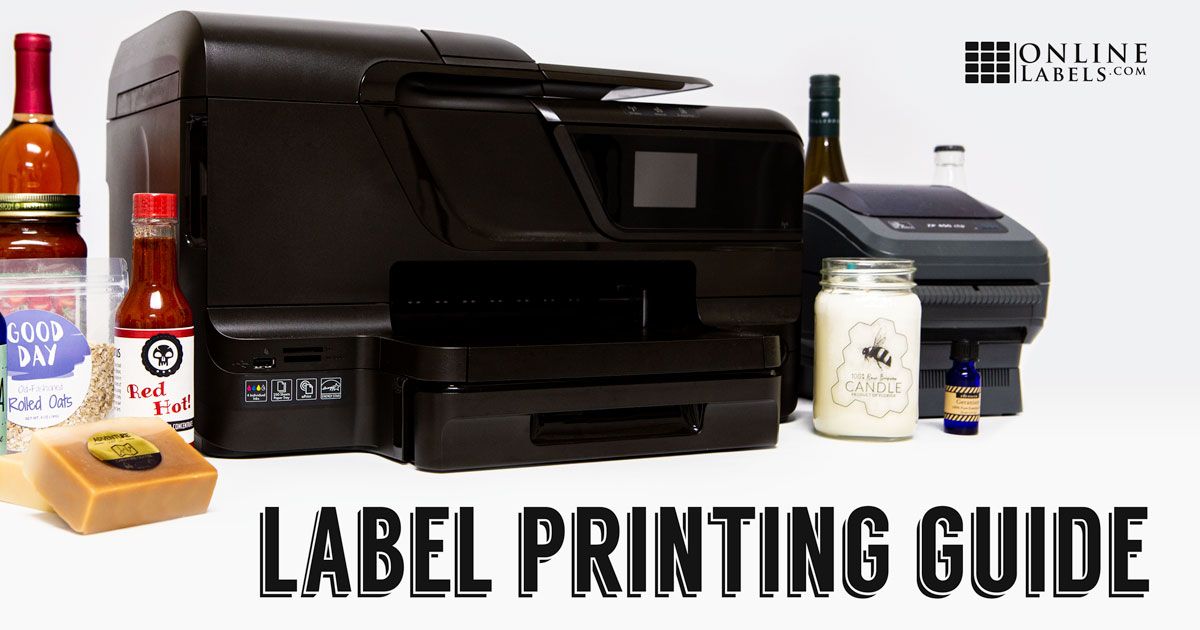How To Print Labels: A Comprehensive Guide

Blank label sheets give everyone the opportunity to create high-quality labels from their home or office. But if you want to make your production value look even higher, read through this comprehensive guide. It features dozens of best practices for designing and printing your labels.
Dive into our expert advice on correctly storing label sheets for later use, designing labels for printing, pre-printing setup, and a few of our prized troubleshooting tricks.
Please keep in mind that there are no set rules for achieving the best results as each printer may perform just a little bit differently. Feel free to try whatever methods you think will work best or give us a call for one-on-one assistance at 1-888-575-2235.
Label Logistics
Before you load your label sheets into your printer tray and get started, read these tips for the best ways to store and handle your labels.
- Keep your labels in the original packaging until you're ready for printing.
- Store your labels in a cool, dry place to avoid humidity.
- Shield your labels from consistent exposure to direct sunlight or fluorescent lighting.
- Make sure your label sheets are stored laying flat. This will help prevent curling or damage to the sheets prior to printing.
- Hold your labels by the edges to prevent smudging or fingerprints.
Check out our full list of product tips for advice specific to each label material and configuration. Simply enter in your product number to get started.
Design Best Practices
Some printing issues can be resolved with changes to your design. Others may be more technical, but design changes can help reduce the visual impact of those problems. With that in mind, here are our recommendations for designing professional-quality labels.
Non-Printable Margins
Most household printers cannot print all the way to the edge of a sheet. You should test your printer's non-printable margins to determine what boundaries you need to observe. Use our non-printable margin tool to figure it out.
Once you know your printer's non-printable margins, think about how to adjust your design. While you have non-printable margins on all four sides of your label sheet, it may only affect one side of each label. If you want your labels to be symmetrical, you may want to remove any borders or full-color designs. This will help prevent any unprinted sections from looking out of place.
See label design examples that account for non-printable margins.
Bleed
You want to add bleed to your label designs whenever possible. Adding bleed means that you add extra design past where your label normally ends. This extra design will extend over the edge of your label.
It exists to adjust for paper-shifting – if your label sheets move a little during the printing process, you're less likely to have blank sections on your label.
If you have a border, make it a little thicker. If you're using a background image, see if you can make it bigger so some hangs off the edge. Using a background color within Maestro Label Designer? Maestro Label Designer will automatically add the bleed for you. See label design examples that include bleed.
In any instance, we recommend adding an extra 1/8" past the border for optimal results. If you're using Maestro Label Designer, you can turn on bleed guidelines to see exactly how much that is.
Safe Zones
Safe zones are the internal version of bleed. You don't want any text or critical imagery butting up against the edge of your labels. We recommend you push your design more toward the middle, by 1/8" (0.125"). The space between your text and your label cut is called the safe zone, or safe margins. Turn on safe zone guidelines if you're using Maestro Label Designer.
This doesn't mean your safe margins need to be empty. You can still include imagery, background colors and more – just keep important elements (like text or your logo, for example) out of this space. See label design examples that observe safe margins.
Circles
Circular labels can be the perfect complement to your packaging, product, container, logo, or design. But at times, they can make achieving the perfect print more difficult. With other label shapes like rectangles, small shifts in any direction are only minimally apparent. With circles, a small shift in any direction (or multiple directions) is highly recognizable.
In addition to the tips outlined above, check out specific design examples and advice for round labels.
Pre-Print Procedures
Confirm the loading and feeding instructions for your specific printer. When it comes time to print, this will tell you how to load the labels properly: which side is the front/back and the top/bottom. You can check your printer manual for this information or test it yourself. Listed below are a few things you want to look out for.
Load & Feed Direction
You should figure out in advance whether to insert the label sheets facing up or down. You don't want to be accidentally printing on the side you discard! As for the feed direction, with most label configurations it won't matter. Our labels are typically perfectly centered on your label sheet, so the feed direction of your printer is irrelevant. But for configurations that have a clear top and bottom, heart labels for example, it's best to know how your printer will handle them ahead of time.
To test these directions, grab a piece of plain printer paper and place it in the printer tray. Write "Up" on the side facing you and draw an arrow from the bottom of the sheet to the top. Print your design and see if it printed on the side labeled "Up" and in the same direction as your arrow. If it didn't, reload a different way and try again.
In the Paper Tray
Separate your labels before loading them into the printer tray. Label sheets can sometimes stick together making it hard for them to feed through individually. You should also stack them neatly and evenly in the printer tray so they feed in as straight as possible.
If you printed your labels and something is a little off, the following tips should help. None of these steps are highly technical, but they do involve changing computer and/or printer settings. If you have any questions throughout the process, you can always call our customer service team for assistance.
Printer Troubleshooting
Alignment Issues
If your design is printing in the wrong place on your label sheet, you are likely experiencing alignment issues. We go more in depth into this topic in our Printer Alignment Guide article, but the summary below is a good jumping off point.
Page Scaling
This problem only affects users printing from PDF documents.
Problem: None of the labels on your sheet are in the right spot, they're all off in different ways.
Explanation: Some PDF viewers have a default setting that shrinks a document to fit "properly" on a 8.5" x 11" sheet. Our templates are already sized to fit correctly, so this setting may do more harm than good.
Solution: Tell the program not to adjust your template. Hit print again but before continuing, review your settings. Make sure that your document is printing at actual size or 100% scale. You don't want "auto rotate and center" or "resize page to fit printer margins" to be selected.
If you don't see these options, your default program may not offer them. In that case, we recommend installing Adobe Acrobat Reader DC. It's a free program with a simple 5-step installation process. Read our step-by-step instructions.
Uniform Misalignment
Problem: Each design printed uniformly too high/low or left/right from the labels themselves.
Explanation: Your printer is feeding the label sheets too fast or slow and/or the printhead is registering the start position too far to the left or right.
Solution: Adjust the margins of your document so your designs match up with the printer's start position. Grab a ruler and find out how far your design is off in each direction. Then, click into "Page Setup" within the "Print" menu in your design program. If your design is too far left, add your measurement to "Left." If your design is too far right, subtract your measurement from "Left." If your design is too high, add your measurement to "Top." If your design is too low, subtract your measurement from "Top."
Smearing/Smudging
Problem: Your design isn't adhering to your label sheets, it's smearing on contact.
Explanation: If you're using an inkjet printer, too much ink is being dispensed onto the page. If you're using a laser printer, the laser temperature isn't strong enough to fuse the toner to the label facesheet.
Solution: For both inkjet and laser printers, adjusting the material setting should help. First, open your printer dialog box and click "Advanced Options." Select the dropdown for "Paper Type," "Type Is," or "Material Type." Switching to "Photo/Glossy" may work, or find the exact setting we recommend.
Non-Printable Margins
Problem: The designs on the edges of your sheet are cut off.
Explanation: Printers can't print on every inch of the sheet, there's always a border around the sheet that it can't reach. Your label design may be outside the printable area in what we call the non-printable margins.
Solution: Modify your design so the non-printable margins aren't noticeable. See the non-printable margins section above for specifics.
Text & Images Outlines
This problem only affects users printing from PDF documents.
Problem: Your design has lines running through it or it looks as if there are squares around some of your graphic elements.
Explanation: PDF viewers can't process all fonts, images, and/or graphics.
Solution: Tell your PDF viewer to read the entire document as an image. Open your printer dialog box and click "Advanced Settings." Check the box next to "Print as Image."
Paper Jams
Problem: Your label sheets keep jamming inside the printer.
Explanation: Jamming isn't a clear-cut science, but it could be a result of thicker-than-normal paper (label sheets) moving through your printer at the standard speed.
Solution 1: Change your material setting. Open your printer dialog box and click "Advanced Options." Select the dropdown for "Paper Type," "Type Is," or "Material Type." Switching to "Labels" may work, or find the exact setting we recommend.
Solution 2: Clean the rollers within your printer. You can test this possibility by printing a blank sheet of printer paper. If it comes out with streaks, your feed path is dirty and could be affecting how well your sheets move through the printing process. Look to your printer's manufacturer for cleaning and maintenance instructions.
Solution 3: Try a different paper tray. The manual feed tray or bypass tray typically include a straighter path through the printer so there are less chances for your label sheets to jam.
Our customer service team is more than happy to help work through any issues you may be having. Call us at 1-888-575-2235 or visit our support page to get started. You may also want to check out related articles on the topic, including Printing Tips and Artwork Guidelines.
You can also take the stress-free route and let us do your printing for you. Submit your design, choose between label sheets or rolls, and we'll have everything printed and shipped to your doorstep in no time. Order custom printed labels today.



